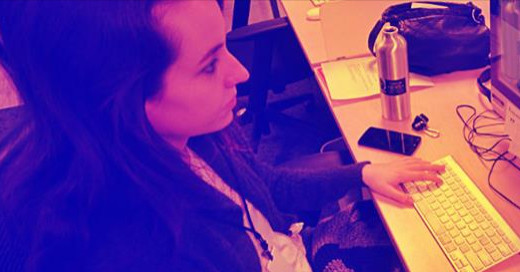Getting editors and designers on the same page
Reprinted from GateHouse Newsroom
I say tomato. You say solanum lycopersicum.
When it comes to reporters and designers working together, trying to create a masterful print or digital product, that's really how different the terminology and level of understanding can be. It takes people with very different skill sets to create something that looks visually appealing, yet conveys all the necessary information that a good centerpiece provides.

So how can you get everyone on the same page when it comes to presentation?
We asked a couple of the Center for News & Design's top performers – Deputy Design Editors Julie Frady and Becca McGovern – to see what can help bridge the gap when it comes to putting together great packages.
Frady has worked at the Chicago Tribune, New York Post, the Los Angeles Times, and the Orange County Register, and now puts her thumbprint on a number of GateHouse papers, including the Wilmington (N.C.) StarNews.
So while she's worked with big newsrooms and small ones, the challenges can be similar. Now, Frady's work is done at a distance – the CND currently designs 56 daily papers and more than 160 weeklies – and the communication aspect is as crucial as ever.
Here are are some suggestions she offers to designers:
• KNOW THE MATERIAL
Frady explained that it's often incumbent on the designer to get familiar with the story or package material. If your job is to design, the better you understand the copy, the better you'll be able to help get the message across.
"Be prepared to have a conversation with editors, writers and photographers so you can talk in-depth about the piece," Frady said. "For example, after reading copy, I will also do Google searches just in case I don't fully understand a topic."
• IT'S OK TO BE 'SKETCHY'
Most bosses frown upon doodling, but not at the CND, where some of the best ideas have come after a designer has taken the time to sketch something out. The pieces come together more clearly on screen if they've been visualized ahead of time.
And don't be afraid to brainstorm with photographers or other editors.
"I do a lot of sketches and will have mock-ups of at least two ideas, so not to spring something on editors. This offers more opportunity for back and forth to either expand an idea or if they have any suggestions to improve," Frady said.
"Also, be able to offer up graphic or illustration ideas. Talking in advance helps if you need to reshoot something."
Meanwhile, McGovern works closely with the Medford (Ore.) Mail Tribune, producing covers for the 25,000-circulation daily that often look like they come from a much larger paper, like a four-part series called "Pot Paradigm" in advance of Oregon's recreational marijuana use changes.
The Syracuse University grad previously worked at the Victoria (Texas) Advocate, and offered the following suggestions for those in the newsroom who are looking to make sure designers have all the pieces they need:

• BRING THE HAMMER
While editors can get crafty with headlines after reading a story, they often forget to take into consideration the photography that will be used with the package.
But McGovern said editors need to be cognizant of all the elements before they use their verbal skills.
"Offer an impactful display or hammer headline, something that's one to three words and relates to both the story and the lead art," she said. "Details work much better in subhead form."
• ART BY NUMBERS
One way to make sure to have a large, dynamic element, according to McGovern, is to be ready to grab a few small facts, like numbers.
Biting off small pieces allows the reader to digest things easier.
"Add sidebars with elements that can be pulled out: Big numbers, or art that can be used at thumbnail size," she said. "These pieces can help add visual layering to the package on both the cover and jumps."
• MOST IMPORTANT: IT'S ALL ABOUT TEAMWORK
McGovern said that one of the biggest keys to pulling off something truly dynamic is making sure to pull together.
"Flexibility is huge," she said. "Sometimes things don't come together as planned (either by designers or by the editors). Flexibility – on both sides – is essential to make sure the package is the best it can be."
Tim Schmitt, project manager with GateHouse Media, has spent decades in various newsrooms – some print and some broadcast. He was a sports reporter, news reporter and then managing editor of his hometown paper, the Tonawanda (N.Y.) News, where he led an award-winning editorial page. He's worked as an editor, staffer or longtime contributor with the Arizona Daily Sun in Flagstaff, the Mesa Tribune, the Arizona Republic, the alt-weekly Buffalo Current and the Niagara Falls Gazette, where he was executive sports editor over four dailies – spearheading coverage of the Buffalo Bills and Sabres. He also worked as a weekend anchor and reporter at Buffalo's ABC-TV affiliate, WKBW, and was the news director of WLVL-AM in the Buffalo market, where he hosted a daily two-hour talk show covering local politics and current events. He moved to Austin to join GateHouse in early 2015.






